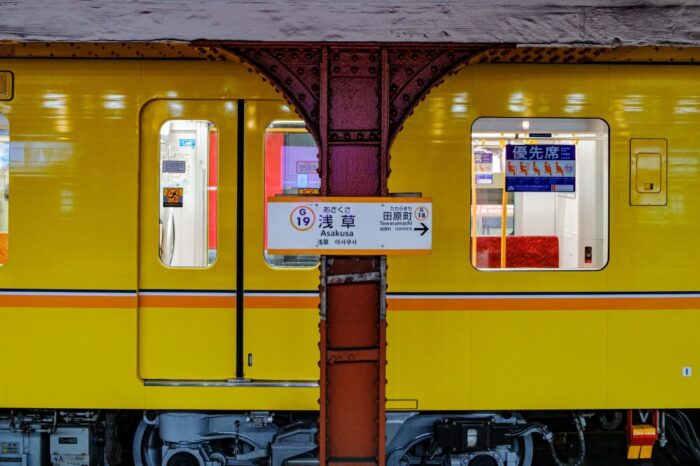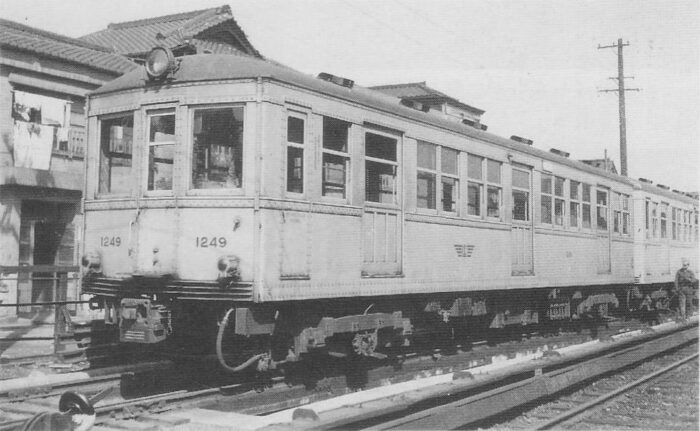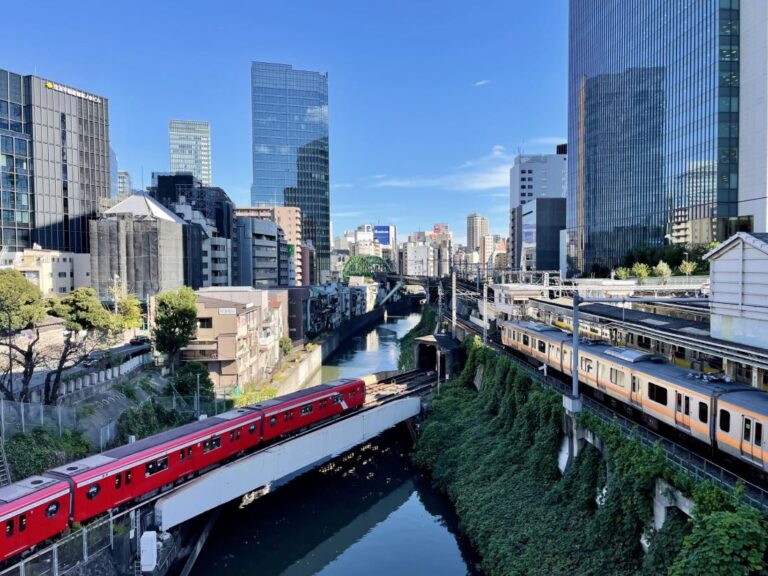The Ginza Line runs from Shibuya Station in the southwest to Asakusa Station in the northeast, passing through the trendy shopping district of Ginza, as well as Ueno Park and Tokyo Skytree. The line is operated by Tokyo Metro, a private transport company, and is known for its distinctive orange color and its role in shaping Tokyo’s urban landscape.

Despite being one of the shorter subway lines in Tokyo, the Ginza Line is packed with history and attractions so there’s a good chance you’ll fins yourself one the orange line while in Tokyo.
Route and Stations

The Line, also known as Line G and connects Shibuya in the southwest to Asakusa in the northeast, passing through some of the city’s most popular and vibrant neighborhoods.
It gives you easy access to many famous landmarks and attractions, such as the iconic Shibuya Crossing, the trendy shopping district of Ginza, and the Sensoji Temple in Asakusa. The line is also an important connection to other subway lines, such as the Marunouchi Line and the Hibiya Line.
There’s 19 stations, with a total length of 14.3 kilometers and the line is entirely underground, except for a short elevated section between Tameike-Sanno and Akasaka-Mitsuke stations.
Look for the bright orange color-code subway maps and station signs.
Here’s a table of the stations on the Ginza Line in Tokyo, Japan, with their connecting lines:
| Station No. | Station Name | Connecting Lines |
|---|---|---|
| G01 | Asakusa | Toei Asakusa Line, Tobu Skytree Line |
| G02 | Tawaramachi | None |
| G03 | Inaricho | None |
| G04 | Ueno | JR Yamanote Line, JR Keihin-Tohoku Line, JR Utsunomiya Line, JR Takasaki Line, JR Joban Line, Tokyo Metro Hibiya Line, Keisei Main Line, Keisei Ueno Skyliner |
| G05 | Ueno-hirokoji | Tokyo Metro Hibiya Line |
| G06 | Suehirocho | None |
| G07 | Kanda | JR Yamanote Line, JR Keihin-Tohoku Line, JR Chuo Line |
| G08 | Mitsukoshimae | Tokyo Metro Hanzomon Line |
| G09 | Nihombashi | Tokyo Metro Tozai Line, Toei Asakusa Line |
| G10 | Kyobashi | None |
| G11 | Ginza | Tokyo Metro Marunouchi Line, Tokyo Metro Hibiya Line |
| G12 | Shimbashi | JR Yamanote Line, JR Keihin-Tohoku Line, JR Tokaido Line, Tokyo Metro Asakusa Line, Yurikamome Line |
| G13 | Toranomon | Tokyo Metro Hibiya Line |
| G14 | Tameike-sanno | Tokyo Metro Namboku Line |
| G15 | Akasaka-mitsuke | Tokyo Metro Marunouchi Line |
| G16 | Aoyama-itchome | Tokyo Metro Hanzomon Line, Toei Oedo Line |
| G17 | Omotesando | Tokyo Metro Chiyoda Line, Tokyo Metro Hanzomon Line |
| G18 | Shibuya | JR Yamanote Line, JR Saikyo Line, JR Shonan-Shinjuku Line, Tokyo Metro Hanzomon Line, Tokyo Metro Fukutoshin Line, Keio Inokashira Line, Tokyu Den-en-toshi Line, Tokyu Toyoko Line |
Each station on the Ginza Line has its own unique character and charm. Shibuya Station is one of the busiest and most famous stations in Tokyo, while Ginza Station is located in the heart of Tokyo’s premier shopping district. Ueno Station is a major transportation hub, serving as a gateway to northern Japan, and Asakusa Station is a popular tourist destination, with its traditional architecture and bustling street markets.
Fares and Tickets

Note that fares are determined by distance traveled, rather than by a particular route or station. The fare for a single trip on the Tokyo Metro Ginza Line ranges from 170 yen to 200 yen, depending on the distance traveled. If you plan to use public transportation extensively, it may be more cost-effective to purchase a prepaid IC card, such as Suica or Pasmo.
When using ticket machines, it is important to note that they only accept cash and prepaid IC cards. Credit cards are not accepted. The machines have an English-language option, making it easy for tourists to purchase tickets.
Attractions Near the Ginza Line

The Ginza Line in Tokyo runs through several neighborhoods, each with its own unique attractions. Here are some of the top attractions near the Ginza Line:
- Ginza Shopping District: The Ginza shopping district is one of Tokyo’s most famous shopping areas. It’s home to luxury department stores, high-end boutiques, and international brand shops. The district is also known for its architecture, with many buildings featuring unique designs.
- Ueno Park: Ueno Park is a large public park that’s home to several museums, temples, and shrines. It’s also a popular spot for cherry blossom viewing in the spring.
- Tsukiji Fish Market: The Tsukiji Fish Market is one of the largest fish markets in the world and you can watch the daily tuna auction and sample fresh seafood at one of the many restaurants.
History of the Ginza Line

The Ginza Line is the oldest subway line in Tokyo and Asia. Established in 1927 and completed by 1934, the line was named after the Ginza district, which is known for its high-end shopping, dining, and entertainment.
It was initially built to be a streetcar line, but it was later converted to a subway line due to the increasing traffic congestion in Tokyo. The original trains were made of wood and rattled along at a maximum speed of 55 km/h.

In 1953, the line was extended from Asakusa to Tawaramachi. In 1967, the line was extended from Shibuya to Naka-Meguro. In 1991, the line was extended from Asakusa to Shimbashi, and in 2008, the line was extended from Shibuya to Hanzomon.
The Sum Up

The Ginza Line in Tokyo is one of the oldest and most popular subway lines in Japan. It connects Shibuya and Asakusa, two of the most popular tourist destinations in Tokyo.
One of the unique features of the Line is its distinctive orange color, which makes it easy to identify. The line is also known for its modern and efficient trains, which run on time and are comfortable to ride.






